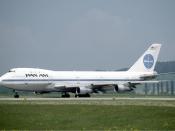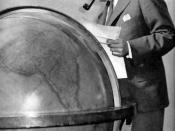Surviving all odds could be considered a slogan for the U.S. Airlines Industry.
Through inflation, depression, terrorist activity and much more the Airline Industry has taken several set backs and still managed to survive. While profits have fluctuate a great deal, the U.S. Airline Industry can be characterized by it steady growth, falling prices and overall stability and contribute a great deal to this economic system. In a brief study of the U.S. Airlines as viewed though certain economic indicators should prove the resilience of this industry. Much like any other business the success and failure are dependant largely on the economic it which operates in. To discuss the impact of the Airlines and macro economics one might look at the background and a few economic indicators.
Certainly in 1903, when the Wright brothers first success flight in Kitty Hawk, North Carolina they had no idea this would mark the beginning of the aviation industry.
(www.scriptorium.lib.duke.edu, July 31, 2005). The public was not ready of airplane travel just yet. The development of the Airline industry could be credited to World War I. After the war, the government stopped funding research and development. Once Charles Lindberg successfully completed a solo flight across the Atlantic Ocean this created a huge interest in flying. Then a variety of air transportation holding companies were formed. One major holding company that is still world recognized, Boeing form its air transportation division in 1928. On big factor that contributed to the growth of this industry was the development of transport mail by the U.S. Postal Service.
In 1926 the Air Commerce Act was passed, allowing Federal relation of air traffic. In 1938 Civil Aeronautics Authority was developed. (www.scriptorium.lib.duke.edu, July 31, 2005) That same year the DC-3 was created to carry both passengers and mail. The...



Industry Overview of the Airline Industry
Fair essay to analyse on the current hot topic of airline industry.
1 out of 3 people found this comment useful.